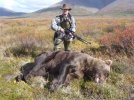Perhaps we should specify what Weatherby means. I had a terrific Weatherby Vanguard rifle that was in 300 Winchester caliber. 300 Winchester is a great caliber and, using Nosler Partitions, I've shot numerous game animals including a 450 lb African lion that was killed with a single bullet. In my opinion Nosler Partitions [I haven't used A-Frames] have one minor problem. They generally mushroom up under the far side skin on medium sized animals. To be certain, this means the animal gets the full "benefit" of the bullet's power but it also means that you don't get a bleeding exit wound in case the animal must be followed up. The Barnes X hollowpoint is, perhaps, better. We just returned from a SA trip in which we used a .338 Winchester loaded with 210 grain Barnes hollowpoints traveling at 2,750 fps at the muzzle. 8 animals were shot from springbok up through zebra, waterbuck and greater kudu. In all cases the bullet exited, producing relatively small exit wounds conforming to the approximate doubling of caliber via expansion. No follow ups required but, if they had been we'd have had both entrance and exit wound blood to follow.
We also used my Weatherby magnum .416 on a large bull giraffe. The bullet is a 400 grain Barnes hollowpoint and is traveling 2,500 fps at the muzzle. The animal was standing in tall cover 100 yds away and the bullet struck him a little far back penetrating thick skin, ribs, rumen full of wet, undigested fodder, liver [the liver was unrecognizable mush], body wall with ribs and mushroomed perfectly under the far side skin. The bullet at penetrated maybe 4.0-4.5 feet of tissue before coming to rest. I've now weighed the mushroomed bullet and it weighs 399 grains. It retained 99.75 % of mass. The animal trotted 60-70 yds, stood and suddenly dropped dead.
My Weatherby .416 is very accurate but does have a muzzle break and a heavy recoil. I'm a little guy at 5'5" but, perhaps surprisingly, care little about recoil. I reckon a kick--even a hard kick--to the shoulder is unimportant. On the other hand, getting hit in the face by a rifle scope mounted on a rifle like this is no joke. I heard of one fellow firing a .416 who had his skull fractured by the scope. Therefore, I'm careful. I've mounted a scope with long eye relief. It's a Leupold 1.5-5.0 power which I feel is adequate for large and/or dangerous game at relative close range. I've also added a rubberized ring to the eyepiece of the scope. I've also put one on my .338 and plan to put such a protective device on my other scopes.
Other than the giraffe, the only other animal shot with my Weatherby .416 was a bull elephant shot with a 400 grain solid. My friend used my rifle and saw only the trunk trip and round of the elephant's back as it fed in tall bamboo, unwisely, he chanced a shot THROUGH the bamboo at a point where he estimated the chest to be. Either he miscalculated or the bamboo deflected the bullet--maybe both. As it turns out the bull was hit--through and through--low on the mid abdomen. Hit with a lesser weapon and the elephant would surely have been lost. As it was the bull went two or three miles leaving only one smudge of blood. We found it lying stone dead. I couldn't stay to examine the animal but the shot was too low for liver, kidneys or aorta. My guess is that the bullet might have hit one end of the spleen. It definitely would have struck small intestine. I rather imagine that the enormous pressures generated by the Weatherby caused massive disruption of mesenteric blood vessels causing the bull to bleed out. One of the advantages of an over-kill weapon [and the Weatherby .416 is an over-kill weapon, in my opinion], is the poorly placed shot. Animals that might be lost with lesser calibers are recovered when hit with a cannon.







